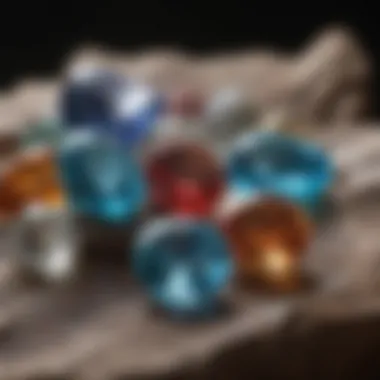The Role of Gemstone Identification Apps


Intro
The world of gemstones is a dazzling landscape filled with colors, history, and intrigue. Yet, for many collectors and enthusiasts, navigating this realm can often feel like walking through a maze. Gemstone identification applications are like a lighthouse piercing through the fog, guiding both novice and seasoned collectors toward informed decisions. These apps are not mere tools; they are bridges linking the beauty of gemstones to the knowledge that empowers collectors.
With technology rapidly advancing, these applications bring sophisticated features within the palm of your hand. Beyond just identification, they offer insights into the intricate universe of gemstones. As we delve deeper into this article, we will explore the significance of these tools, highlight technological advancements, and examine how they play an essential role in transforming the hobby into a more enriching experience.
Join us in our journey as we uncover the layers of gemstone identification applications and their contribution to a thriving community of enthusiasts.
Preface to Gemstone Identification Apps
In a world where digital technology intertwines with our daily lives, gemstone identification apps emerge as a notable innovation for enthusiasts and collectors alike. Understanding these applications is crucial as they enhance the experience of identifying, appraising, and ultimately enjoying gemstones. These tools bridge the gap between art and science, offering both novice and seasoned collectors deeper insights into their treasured specimens.
Defining the Concept
Gemstone identification apps serve as portable libraries of knowledge at our fingertips. They utilize a combination of visual recognition software and extensive gemstone databases. Take for example an app that can analyze a photo of a gemstone to determine its type by matching factors like color, luminescence, and inclusions. This capability transforms the laborious process of identification into a streamlined, efficient task. Moreover, such apps often include features like guides on care techniques and folklore associated with different stones, enriching the collector's experience even further.
Furthermore, the significance of these apps extends beyond mere identification; they allow users to catalogue their collections digitally. As many collectors will tell you, keeping track of each piece, including its origin and quality, can be daunting. With a few taps on a smartphone screen, users can essentially create a digital archive of their precious finds, simplifying both enjoyment and display.
Historical Context
Historically, gemstone identification relied heavily on physical examination by experts, which could often be inaccessible to the average person. In the earlier days of geology, collectors would need to attend exhibitions or consult sophisticated reference works to understand what they had in their possession. This system was slow and required a certain level of education in gemology, often leaving out many eager enthusiasts.
The advent of technology changed the game dramatically. In the late 20th century, technological innovations began to emerge, but they often came in the form of expensive equipment that was out of reach for most collectors or hobbyists. It wasn't until the rise of smartphones that a significant shift occurred. Once smartphones began incorporating cameras with advanced capabilities, developers seized the opportunity to create apps that democratized access to gemstone information. With the help of community input—for example, forums on Reddit and Facebook—knowledge began to spread more rapidly than ever before.
"There was a time when identifying a gemstone was akin to solving a mystery. Now, an app can crack the case in seconds."
This historical transition reflects a broader societal trend: one where knowledge and information become increasingly accessible to the general public. Today, collecting gemstones isn't just a hobby for the few; it has blossomed into a community enriched by shared knowledge and resources, thanks largely to the rise of gemstone identification applications.
The Evolution of Technology in Gemstone Identification
The rise of technology has reshaped various fields, and gemstone identification is no exception. As collectors and enthusiasts venture deeper into the complex world of gemstones, the need for accurate identification becomes increasingly paramount. The evolution of technology not only simplifies this process but also opens doors to myriad possibilities for enthusiasts to understand their gems better.
In a world where the market is flooded with synthetic and treated stones, accessing reliable and precise information can make or break a collector's journey. A solid understanding of the technological advancements in the field serves as a foundation for both novice and seasoned enthusiasts. Furthermore, these advancements have helped elevate the hobby into a sophisticated area where knowledge reigns supreme, not just about the gemstones themselves but also about the intricate details that define their worth and provenance.
Advancements in App Development
The development of gemstone identification apps marks a significant leap in how both casual hobbyists and professional gemologists interact with their collections. One notable advancement involves the intuitive design of interfaces, allowing users to navigate the app with ease, even if they don’t possess extensive knowledge about gemology. For example, apps such as GemCheck and GemLab enable users to identify stones simply by using their smartphone cameras. Just a few taps, and a user can receive a detailed analysis of their gem, which could take an expert hours to accomplish manually.
Moreover, features like augmented reality are beginning to take root, allowing users to superimpose information directly onto a gemstone image. Such tools not only provide identification but also offer information regarding care, historical significance, and even price values in real-time. This integration of technology has lightened the load for enthusiasts, radically transforming the educational experience.
Integration of Artificial Intelligence
Artificial intelligence (AI) brings another layer of sophistication to gemstone identification. With applications poised to learn and adapt from vast databases, AI can accurately distinguish between very similar stones with remarkable precision. This capability helps in pinpointing subtle differences in color, clarity, and even origin. Imagine taking a picture of a gemstone with your phone; within moments, the app can analyze the image and provide multiple potential matches based on a comprehensive algorithm that processes previous data.


"AI serves as the backbone of many modern identification tools, constantly advancing and refining our understanding of rare gems."
Moreover, machine learning technology can develop over time, continuously improving its accuracy as larger datasets become available. This capacity to evolve enables collectors to have a reliable tool that enhances their decision-making, ultimately leading to smarter purchases and a deeper appreciation of their gems. As technology marches on, we can expect the synergy of AI and gemstone identification apps to bolster the community and facilitate a deeper, more informed connection between collectors and their cherished stones.
Key Features of Gemstone Identification Apps
In the ever-evolving landscape of gemstone collecting, the emergence of gemstone identification applications has revolutionized how enthusiasts and collectors engage with their passion. These tools not only enhance the user experience but also provide significant practical benefits. Knowing the key features of these apps can help users make informed decisions about their gems, making them an invaluable resource in the field.
User-Friendly Interfaces
A core element of any successful app is its user interface, and for gemstone identification apps, simplicity is paramount. A user-friendly interface means that anyone, from a novice hobbyist to a seasoned collector, can navigate the app with ease. Intuitive designs help in quickly accessing various functions such as searching for gem types, viewing identification methods, or exploring educational content.
For instance, imagine someone new to the world of gemstones, overwhelmed by the vast variety available. With an easy-to-use interface, they can effortlessly tap on a gem's image, and immediately receive information about its characteristics, origins, and care instructions.
Furthermore, many apps utilize color-coded sections or graphic icons, making it visually appealing and straightforward. This aspect is important, as it can decrease the learning curve, inviting more people to appreciate the art of gemstone collecting. Just as a well-organized toolkit makes repairs easier, a user-friendly app simplifies the identification process.
Real-Time Identification
Real-time identification is a standout feature that captures the essence of modern technology. With advanced camera capabilities, users can simply point their smartphone at a gemstone for immediate analysis. Utilizing a combination of image recognition software and built-in databases, these apps provide instant feedback on the type of stone in question. This can be particularly useful when attending trade shows or gem fairs when quick decisions must be made.
Imagine navigating through a bustling market, where a seller presents what they claim is a rare sapphire. With a quick scan, the app might reveal it to be a treatment-enhanced stone or even a different variety altogether. This immediacy not only protects consumers but enriches knowledge, allowing users to ask informed questions about their potential purchase.
"Speed and accuracy in gemstone identification can make or break a collector's experience."
Detailed Gemstone Profiles
The depth of information provided by gemstone identification apps is a crucial feature that merits attention. Each identified stone can come with detailed profiles that outline its physical properties, historical significance, and even tips for care and maintenance. These profiles serve as a rich educational resource, enriching the collector's understanding of their gemstones.
For example, if a user scans a periwtle gem, they might unlock a comprehensive profile that explains its unique chemical composition, highlights its metaphysical properties, and even presents its market value. By integrating detailed information, apps foster a deeper appreciation for gemstones, turning a simple hobby into a passionate exploration.
Additionally, users can upload their own gemstone findings and contribute to the growing database, thereby creating a community focused on learning and sharing knowledge. This encourages an ongoing dialogue among collectors, ensuring that everyone is not just a passive user but an active participant in this vibrant niche.
In summary, the key features of gemstone identification apps—user-friendly interfaces, real-time identification capabilities, and detailed gemstone profiles—not only bring convenience but also facilitate a deeper connection between collectors and their gems. These elements are essential, fostering a well-informed community while enhancing the enriching hobby of gemstone collecting.
The Role of Gemstone Identification in Collecting
Gemstone identification apps play a pivotal role in the world of collecting by equipping enthusiasts with the tools necessary for informed decision-making. The craft of collecting isn’t merely a hobby for many; it’s a passion, sometimes bordering on an obsession. App technology lends itself to deepening that passion by helping collectors enhance their understanding and appreciation of gemstones.
Enhancing Collectors' Knowledge
When it comes to collecting, knowledge is power. The more collectors know about the gemstones they’re handling, the more they can appreciate their value and uniqueness. Gemstone identification apps serve as a treasure trove of information. With just a quick scan, an app can offer specifics about the gemstone’s origin, properties, and historical significance. This means a collector can go from merely owning a piece of amethyst to understanding whether it was sourced from Brazil or Zambia, and what that means for its value.
Furthermore, many of these applications feature learning modules that go beyond mere identification. They can include quizzes, articles, and interactive forums, fostering a sense of community. This process is crucial; a well-informed collector can distinguish genuine gemstones from imitations, preventing costly mistakes. They can also learn the nuances of different gem cuts and qualities, broadening their expertise beyond surface-level recognition.
"Knowledge isn’t just about accumulation; it’s about understanding context. A collector who knows the ‘what’ and the ‘why’ of their gems is more equipped to appreciate their collection in a meaningful way."


Identifying Rare and Valuable Gems
For serious collectors, the thrill often lies in the hunt for rare and valuable gems. Identification apps enhance this exhilarating search. By leveraging these digital platforms, collectors can ascertain not just the type of the gemstone but also its rarity and market demand. Some features allow users to input specific criteria, yielding a list of comparable gemstones and current market values.
Additionally, these apps often incorporate databases that provide historical auction results and sales trends. Such information becomes vital when evaluating the desirability of a gemstone. If a collector is considering investing in a unique blue diamond, for example, the app can show them sales records and rarity metrics, giving them a clearer operational landscape.
Another striking benefit is the ability to quickly and effectively verify authenticity. In a world where counterfeits are increasingly prevalent, having an app to cross-check information becomes indispensable. Collectors can use images or detailed descriptions within the app to match with known characteristics of rare gems, saving time and mitigating potential losses.
In summary, gemstone identification apps are not just about placing a name on a stone. They enhance collectors' knowledge and skills, making the entire process more rewarding and enriching, while also providing critical insights into the often complex landscape of gemstone trading.
Practical Applications of Identification Apps
Gemstone identification applications shape the way collectors engage with their treasures, broadening their understanding and appreciation for the intricacies involved in this field. These tools serve a critical role, fusing technology with the age-old passion for collecting gems. Using such applications allows individuals to gain deeper insights into their collections, making them invaluable resources for both novices and seasoned collectors alike.
Assessing Gem Quality
Evaluating the quality of gemstones remains a fundamental aspect of any collector’s journey. Identification apps provide a range of features that assist in systematically assessing the characteristics of each stone. Among the attributes examined are clarity, cut, color, and carat weight—the four Cs that help establish a gem's overall value.
- Clarity: These applications often incorporate advanced imaging techniques to check for inclusions or blemishes. This helps collectors understand how 'clean' their stones are compared to market standards.
- Cut: Tools for analyzing cut quality help ensure that a gemstone reflects light in an optimal manner, contributing to its brilliance and aesthetic appeal. Some apps even simulate how light interacts with different cuts, giving users a practical grasp on this aspect.
- Color: Users can compare their gems against a color spectrum. Such features are crucial for determining if a stone meets the desired hue or shade that might command a higher price.
- Carat Weight: Calculation tools for carat weight, based on measurements entered by the user, make it easier for sellers to accurately price their gems within competitive marketplaces.
This holistic assessment bolstered by smartphone power offers far more accuracy than manual evaluations. App-driven quality assessment becomes an essential practice for collectors who wish to invest wisely.
Verifying Authenticity
The age of forgeries and imitations brings about a critical necessity: the need to verify the authenticity of gems. The use of identification apps here holds substantial weight. With advanced AI and machine learning capabilities, these tools can dissect even the minutest details of stones, assisting users in confirming their authenticity through comparison against extensive databases and pre-stored information.
- Database Comparisons: Many apps come with built-in databases where users can match gemstones against known samples. This provides collectors with a quick way to assess whether their stones are genuine or counterfeits.
- Ultraviolet Light Detection: A feature available in some apps is UV light emission analysis, which can reveal characteristics that are unique to genuine stones, indicating whether a gem is real or synthetic.
- User Community Inputs: Knowledge-sharing through forums and community feedback within these applications lets users tap into a collective intelligence, which can be invaluable to validate what they possess.
Greater knowledge and authenticity verification empower enthusiasts to engage in informed transactions. This feature is especially significant in a world where artificial stones can easily mislead even the most experienced eyes.
"In the realm of gemstone collecting, authenticity isn’t just a status; it’s a fundamental truth determining the value of a collector’s passion."
The practical applications of identification apps run deep within the world of gemstone collecting. They not only elevate the collector's experience but also ensure that individuals are well-equipped to navigate the often murky waters of gem trading. This engenders a community that values education, authenticity, and quality—an essential triad for any serious gemstone enthusiast.
Challenges in Gemstone Identification
When delving into the realm of gemstone identification applications, it’s essential to recognize the hurdles that accompany this technological journey. While these applications serve as invaluable tools for collectors and enthusiasts, they are not without their complexities. Understanding these challenges is crucial, as it highlights areas for improvement and informs users about the limitations they might face when relying on these apps for identification purposes.
Limitations of Current Technologies
As the old saying goes, no tool is perfect. In the world of gemstone identification, current technologies can display a range of limitations that users must navigate. For starters, many apps rely heavily on photography, which mandates optimal lighting and angles to capture the true essence of the gemstone. If a user snaps a picture in poor lighting, the app's identification accuracy can nosedive.
Furthermore, many identification apps employ algorithms that may not accurately differentiate between similar-looking gems. Take, for example, the confusion between various types of quartz like citrine and amethyst. They both present similar color ranges, yet their value can differ significantly. This leads to potential misidentification which could result in significant financial repercussions for buyers and sellers alike.
Additionally, the data repositories that these apps utilize may not always encompass every gemstone. Some rare gems could be omitted or poorly documented, leading to frustrating experiences for those who stumble upon unique finds.


As such, while these applications provide a gateway for better understanding gemstones, it's important to approach them with careful consideration.
Increasing Complexity of Gemstone Varieties
The gemstone world is an ever-expanding universe that constantly introduces new varieties and enhanced treatments. You might think identifying a gemstone is straightforward. However, the increasing complexity of varieties complicates the process significantly. For instance, the distinction between natural, treated, and synthetic stones can blur, particularly in the case of high-quality lab-created gems that mimic their natural counterparts perfectly.
Furthermore, the sheer volume of gemstones available in the market today is staggering. With names that can twist the tongue—such as tanzanite, bloodstone, and spinel—it’s no wonder enthusiasts often feel overwhelmed. Each variety comes with its own set of characteristics and potential imitations. When a novice collector encounters a stone they cannot readily identify, they may not just struggle with identifying the stone itself but also face a crisis of confidence in their collecting hobby.
"Even seasoned gemologists may find themselves baffled by the rapid development of new treatments and synthetic variants, which can easily masquerade as natural gems."
Additionally, as gemology progresses, advancements in treatments such as coating or laser drilling can further complicate the identification process. This deepening complexity raises questions about authenticity, potential devaluation, and ethical implications in the market. As a result, gemstone identification applications must continuously evolve to keep pace with these changes, providing users with reliable tools to navigate this intricate landscape.
In summary, recognizing the limitations of current technologies and the complexities introduced by the diverse range of gemstones is vital for any collector or enthusiast. These challenges shape the way individuals engage with their collections, promoting a more informed and cautious approach rather than a haphazard one.
Future Trends in Gemstone Identification
The landscape of gemstone identification is poised for remarkable evolution, particularly as technology continues to advance at a breakneck pace. These emerging trends not only have the potential to revolutionize how gemstones are identified but also enhance the overall experience for collectors and enthusiasts alike. Understanding these trends is critical for anyone engaged in the field, as they have implications for accuracy, accessibility, and the broader market.
Predicted Technological Innovations
As we venture into the future of gemstone identification, several cutting-edge technological innovations are anticipated to reshape the way we approach this age-old hobby. One significant trend lies in the application of augmented reality (AR). Imagine pointing your smartphone at a gem, and instantly, detailed information pops up, showcasing everything from its origin to its chemical composition. Such tools are expected to bridge the gap between novices and seasoned collectors by providing instant access to precise data.
In addition, advancements in machine learning algorithms promise to enhance real-time identification capabilities. These algorithms can analyze vast datasets of gemstone properties, refining the identification process to unprecedented levels of accuracy. Importantly, as more enthusiasts contribute their findings and experiences to platforms online, the database for these algorithms can grow, further enriching the technology.
"Emerging technologies will not only foster accuracy but also democratize knowledge among gemstone enthusiasts, allowing for informed decisions during purchases and trades."
Furthermore, the potential integration of blockchain technology cannot be overlooked. By documenting a gem’s journey from mine to market, blockchain could significantly improve the traceability and authenticity verification of gemstones, combating fraud and enabling collectors to invest with confidence.
Potential Market Growth
The gemstone identification market stands on the brink of substantial growth, driven by both technological advancements and increasing consumer interest. As more individuals turn to gems for personal collections or investments, demand for user-friendly identification apps is expected to surge. This uptick in interest can be attributed to a growing awareness of the importance of accurate identification in ensuring the value and integrity of these precious stones.
Interestingly, younger generations seem more inclined toward handheld technology and mobile apps. As they enter the market, their purchasing habits could lead to innovative trends and preferences, prompting companies to mobilize resources into developing advanced apps designed to cater specifically to their needs.
Investors are likely to take note of this emerging market landscape, recognizing the lucrative opportunities associated with enhancing gemstone identification solutions. Start-ups and established technology firms are likely to collaborate to create unique features, making these apps not just tools for identification, but multifunctional platforms for education and community engagement.
In summary, as we look ahead, the intertwining of technology and the jewelry market is set to redefine the art of gemstone identification. By embracing innovation, the community can enhance knowledge sharing, improve investment security, and foster a deeper appreciation for the exquisite world of gemstones.
End
In the ever-evolving landscape of gemstone collection, the emergence of gemstone identification applications stands out as a game changer. These apps do more than just serve as a nifty gadget for those with a penchant for pearls and precious stones; they offer significant educational value and practicality. By integrating advanced technology, these applications help users distinguish between fact and facade, enhancing the overall experience of both novice and seasoned collectors.
Summarizing Key Insights
The integration of user-friendly interfaces and real-time gemstone identification elevates the collector's journey. Apps like GemLab or iGem, allow users to quickly assess the authenticity of a stone with just a click. Detailed profiles provide insights into gem quality, origin, and market trends, which can help potential buyers make informed decisions. Additionally, the role of artificial intelligence in these applications is pivotal—it not only streamlines the identification process but also ensures accuracy, helping individuals navigate through complex gemstone varieties. This confluence of technology and gemology truly enhances the collecting experience.
The Importance of Continued Learning
The world of gemstones is vast and constantly changing. As new varieties emerge and old ones resurface, staying updated with the latest developments is crucial. Collectors should aim for continual education, whether through attending workshops, following expert gemologists on social media platforms like Facebook or participating in community discussions on Reddit. Continued learning fosters an informed collector who doesn't merely rely on technology but complements it with knowledge.
"Knowledge is like a garden; if it is not cultivated, it cannot be harvested."



